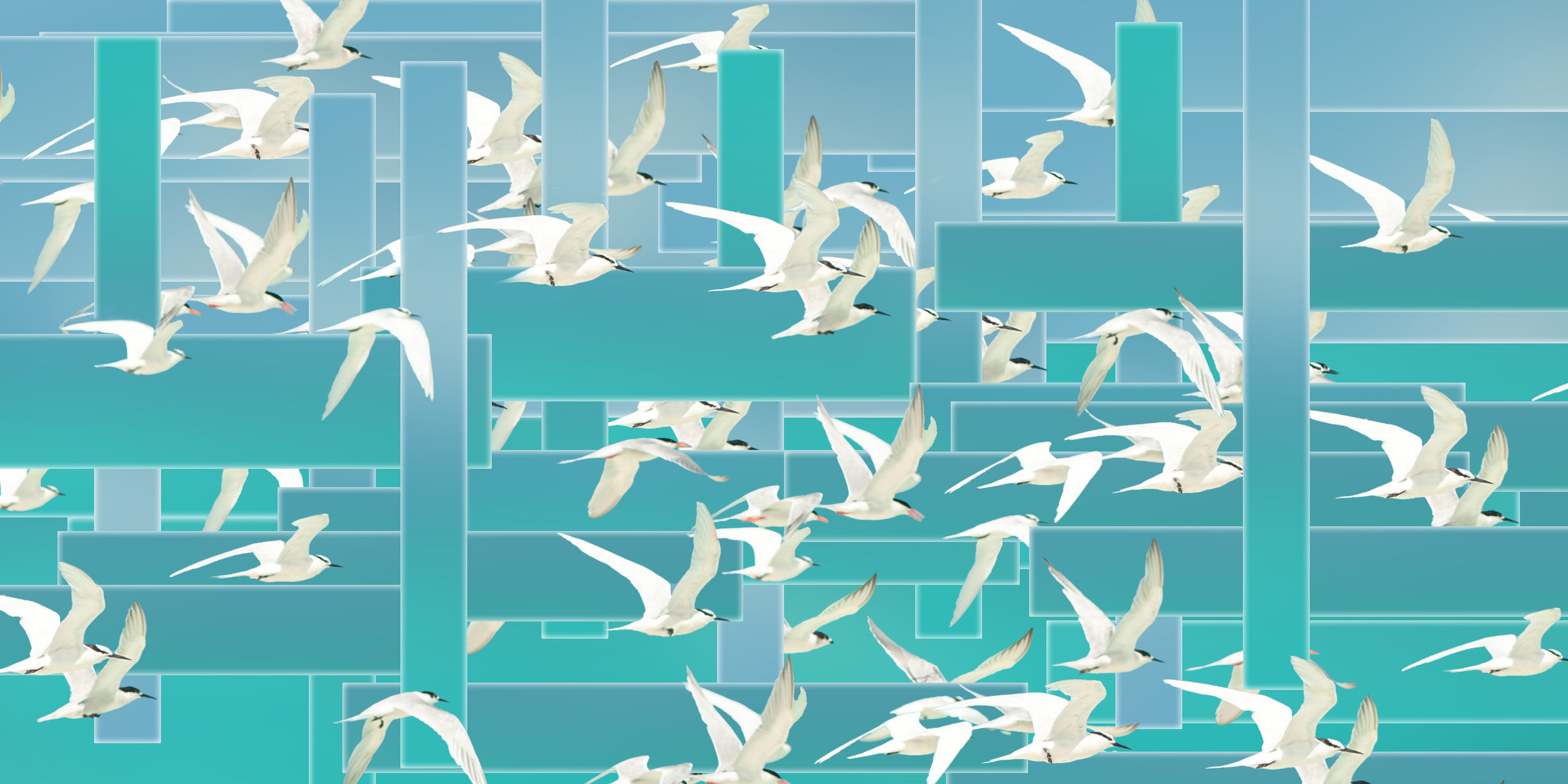the rhythm in the birds came about from two moments: while on tour and after discussing the parameters of this commission, a band member suggested that I look for the ‘silence in the birds’
following that conversation, I went and sat outside to observe and listen to birds every so often. what struck me in the midst of that silence were the rhythms being communicated and the way that they were being expressed.
each individual bird had its own personal rhythm, personal melody, and personal flight path. yet there were always constantly at least two or three birds, generally in the same vicinity, seemingly working together for the same goal.
their flights, rhythms, and songs weren’t always accurately expressed altogether or in unison; but when brought together, they created beautifully layered textures that moved and flowed together.
wingbeat uses the flight formations of migratory birds as a model for listening and collectively maintaining energy. To conserve energy for long distance flights, birds fly in V formations, stagger their wingbeats, and react quickly to each other. Musicians are prompted to create sonic representations of this organically rhythmic phenomenon. The buildup of wingbeats earns moments of soaring, and sometimes flight is interrupted. The series of text cues aims to challenge and facilitate the project of sonic togetherness.
This work is inspired by the story of the birth of Pegasus, the winged-horse from Greek mythology. The work opens up in canonic form, depicting biophonic sounds that might be heard near the Gorgon cave, home to Medusa, mother of Pegasus. This biophony eventually gives way to the sounds of the approaching hero, Perseus, who arrives with might to slay Medusa. Pegasus is born from the blood of Medusa and as its wings spread for its first flight the piece opens in-kind. As Pegasus flies away, the work returns to the biophonic sounds near the cave, now witness to one of the great events of Greek Mythology.
yes you are this much I wrote this while listening to the spring birds. In the village where I live, there are thousands of them, and they are my favorite meditation music. I wish to be like a bird, expressing myself without inhibition and with great purpose.
Commissioned by the Metropolis Ensemble for the premiere in Brooklyn Botanic Garden, Twelve Miniature Etudes is inspired by the different techniques, music elements and timbre that can be produced by various instruments. Colors I is a movement of long holding notes that build chords. Bullet Notes are melodic lines produced by fast running notes connected from one instrument to the other. Ostinato Rocks are ostinatos with polyrhythms. Imitation You and I is created by musicians imitate each other’s sound, melody, and rhythms. Funky Chords is a movement with three sets of harmonic progressions that musicians use to improvise. In Scale Plays, players use octatonic scale(s) to build a three-part structure. The sound in Duets is produced by paring of instruments. In Unison Tuning, everyone starts by playing a single melodic line and then alternates after that. Composite Hockets is created by rhythmic hockets with different groups. In Chain II, short melodic lines are created and passed around musicians using eye contacts. Rhythm Blocks builds on single note chosen by each player and rhythmic patterns created by them. Colors II is an echo of Colors I.
This piece is inspired by the feeling of watching videos of starlings flocks on the internet when I was 12. I spent a while researching the patterns and very complex communication behind their beautiful flocking patterns while writing this music. I was pretty staggered at the complexity of their communication amongst up to 750,000 birds. Apart from protecting itself from predators, these shapes also happen as an act of joy, a natural want to move and dance. A lot of the material in this piece comes directly and indirectly from these shapes. I’ve always been and still am very scared of birds but I really love watching them from afar.
The piece Migration Before the Storm is inspired by two common and fascinating bird behaviors: Migration and the group dynamic right before a drastic weather change, such as a storm. Both of these specific behaviors can happen in large groups and in this piece are represented by 4 tonal centers that appear in different shapes, dynamics and tempos
This piece revolves around mimicking the motions of birds in a flock – individual variations moving together towards the same direction. While there’s a beginning and end to the piece, everything cycles back on itself much like birds migrating and returning home. The paths of the flock as a whole remain largely the same, but the movement of each individual varies slightly each time
As a kid, I dreamed of being a bird. To me, they were truly free: soaring across the sky, singing, looking down at us from the treetops, nesting anywhere they liked. As I got older, I was fascinated by the stories of their epic migrations. I imagine that though the departure and arrival points of these migrations are probably similar, each journey must be unique; when one rests, how close to the flock one flies, and the weather must make each trip unique. My hope is that flightpath provides a similar experience, where one knows the points of departure and arrival, but is free to shape their individual journey.
Inspired by the Flightless Cormorants. These birds are an endemic species to the Galapagos Island, and just like their name implies, they cannot fly. Because of this they are confined to the shoreline they inhabit. Although these birds have lost their ability to fly, they are impressive swimmers, and important underwater predators. Flightless is a musical ‘slice of Flightless Cormorant life’ piece. Each performer represents ad individual bird. How much time do these birds spend on land vs. water? How many dives do these birds take? How will these birds interact when their paths cross?
Birds is inspired by bird sounds and their rhythmic sense. This concept reimagines the life of a bird from its morning rise to its last call. The bird seems to have a natural progression in which that happens, and allowing each section of this piece to flow into the next is the key to bringing this piece to life. All sections are meant to be repeated until the material is fully internationalized by listeners. This may mean repeating 4-5 times per section, the only section played 1 time is the last call. There must be at every performance a natural leader cueing each section and fermatas. The idea is to be musical interpreting those held notes to create a building effect leading up to the last call.
This work was inspired by the calls and sounds of six different birds - Western Meadowlark, House Wren, Hermit Thrush, Black Rail, Eurasian Nightjar, and Night Heron. Each of the four movements of this piece combines elements from several of the sounds or patterns that one or more of these birds produce and has them work together.
Réfréner attempts to construct methods of group interaction and listening that enable improvisation across different rhythmic textures while retaining a core melodic character. It is inspired by my ongoing research into the social and geographic movements that shaped the genesis of swing in America in the early twentieth century. The title comes from the etymology of the word “riff”- a shortening of refrain, from the French Réfréner. It was commissioned by Metropolis Ensemble for Biophony 2021.
Brownstone was originally a site-specific electro-acoustic composition/installation by Jakub Ciupinski (2010 Metropolis Ensemble commission) and performed throughout an entire three-story Brooklyn brownstone.
In the original, musicians were scattered throughout all three floors while audience members freely wandered, explored, and choosing their own experience of the piece.
The source material for the electronic music layer was derived from the BBC Nature Sound Effects Library, provided by Pro Sound Effects. In this new version for Biophony, instruments will be spread out throughout an outdoor area in nature, but remain within earshot from one to the other, with sounds from the natural environment replacing the electronic track.
Metropolis Ensemble’s Biophony project and platform was in part inspired by this piece.
Rubix’s Kingdom is a sonic Role Playing Game whose objective is to direct all players towards an approximate and artistically compelling synchronicity.
Tkaronto (Iroquoi for “the gathering place”, or “where trees stand in shallow water") also known as Toronto, inhabits the traditional territory of many nations, including the Mississaugas of the Credit, the Anishnabeg, the Chippewa, the Haudenosaunee and the Wendat peoples. While the three composers’ ancestral ties are from China, Ethiopia, Eritrea, Lebanon, Ireland, and France, they currently live in Toronto where the pursuit of art and creativity unites them. Trees are at the sonic hard of this piece, with musical elements generated from the variety of trees and their color found near their homes.
The word “YEI” means the number three in the native Mexican language of Nahuatl, where it’s still spoken to this day in Veracruz. Via distinctive and varying loops performed by each player, the piece’s ternary form uses techniques to create a complex pitch and rhythm aggregate.























